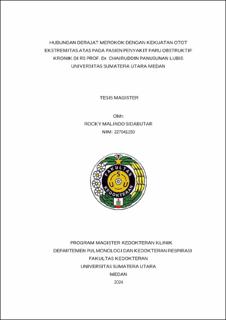Hubungan Derajat Merokok dengan Kekuatan Otot Ekstremitas Atas pada Pasien Penyakit Paru Obstruktif Kronik di RS Prof. Dr. Chairuddin Panusunan Lubis Universitas Sumatera Utara Medan
The Relationship Between The Degree Of Smoking with Upper Extremity Muscle Strength in Patients Chronic Obstructive Pulmonary Disease at Prof. Dr Chairuddin Panusunan Lubis Hospital University of North Sumatera Medan

Date
2024Author
Sidabutar, Rocky Malindo
Advisor(s)
Permatasari, Amira
Pandia, Pandiaman
Ashar, Taufik
Metadata
Show full item recordAbstract
Background : Chronic Obstructive Pulmonary Disease (COPD) can lead to a
decline in muscle strength, including the upper extremity muscles, which can affect
patients' quality of life. Although smoking is known as a major risk factor, the
relationship between the degree of smoking and upper extremity muscle strength in
COPD patients has been minimally studied, especially in North Sumatera. This
study aims to analyze the relationship between the degree of smoking and upper
extremity muscle strength in COPD patients at RS Prof. Dr. Chairuddin Panusunan
Lubis University of North Sumatra Medan.
Methods: This study employed a descriptive observational design with a cross
sectional approach, conducted from August to December 2024. The Brinkman
Index and upper extremity muscle strength measurement using the Handgrip
Dynamometer were used to collect data.
Results: This study involved 69 patients with an average age of 64.5 ± 8.34 years,
with the majority being male (76.8%). A total of 22 patients (31.9%) had no history
of exacerbations. Smoking degree was measured using the Brinkman Index, with
16 patients (22.2%) in the light smoker group, 17 patients (24.6%) in the moderate
smoker group, and 36 patients (52.2%) in the heavy smoker group. Upper extremity
muscle strength was measured using the Handgrip Dynamometer, with 37 patients
(53.6%) having normal muscle strength, while 32 patients (46.4%) had weak
muscle strength. Most patients in the light and moderate smoking groups had
normal muscle strength, whereas in the heavy smoking group, 31.8% had weak
muscle strength, and 14.8% had normal muscle strength.
Conclusion: Statistical tests showed a p-value of 0.023, indicating a significant
relationship between the degree of smoking and upper extremity muscle strength.
These findings could serve as a basis for developing a more comprehensive COPD
management strategy, considering smoking risk factors and efforts to prevent
muscle strength decline to improve patients' quality of life.
